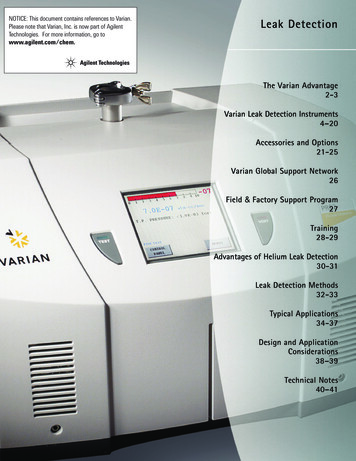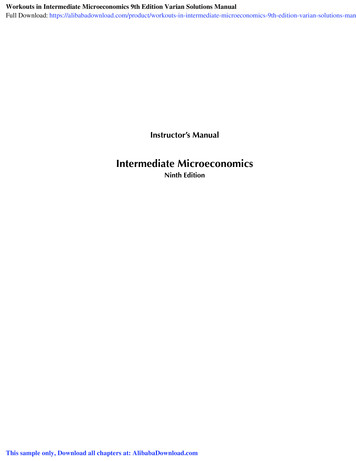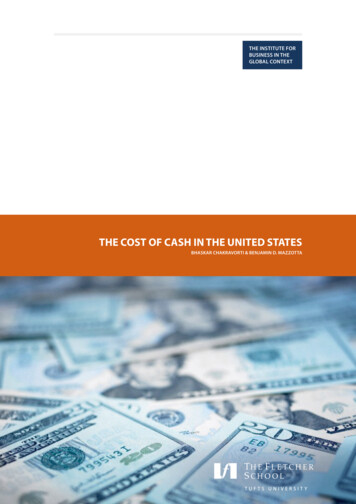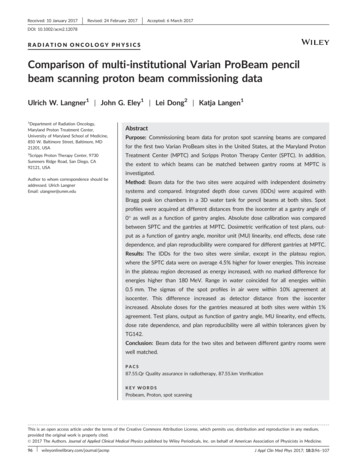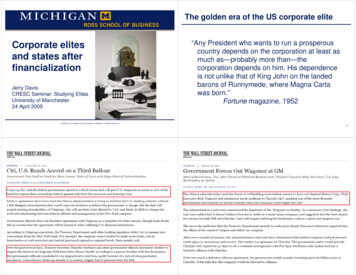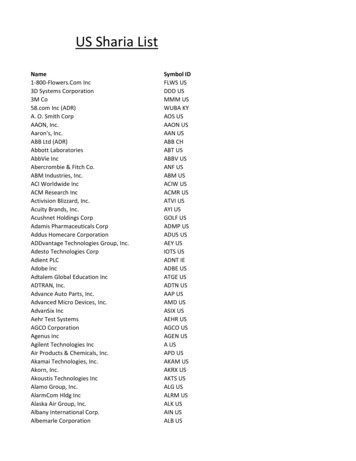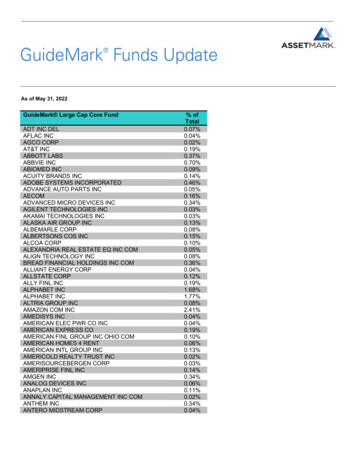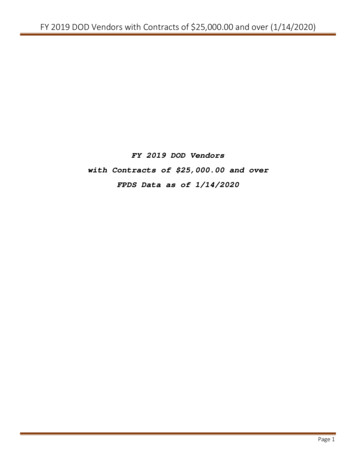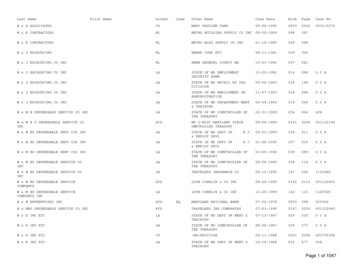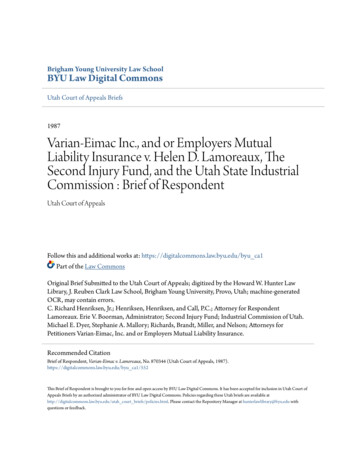
Transcription
Brigham Young University Law SchoolBYU Law Digital CommonsUtah Court of Appeals Briefs1987Varian-Eimac Inc., and or Employers MutualLiability Insurance v. Helen D. Lamoreaux, TheSecond Injury Fund, and the Utah State IndustrialCommission : Brief of RespondentUtah Court of AppealsFollow this and additional works at: https://digitalcommons.law.byu.edu/byu ca1Part of the Law CommonsOriginal Brief Submitted to the Utah Court of Appeals; digitized by the Howard W. Hunter LawLibrary, J. Reuben Clark Law School, Brigham Young University, Provo, Utah; machine-generatedOCR, may contain errors.C. Richard Henriksen, Jr.; Henriksen, Henriksen, and Call, P.C.; Attorney for RespondentLamoreaux. Erie V. Boorman, Administrator; Second Injury Fund; Industrial Commission of Utah.Michael E. Dyer, Stephanie A. Mallory; Richards, Brandt, Miller, and Nelson; Attorneys forPetitioners Varian-Eimac, Inc. and or Employers Mutual Liability Insurance.Recommended CitationBrief of Respondent, Varian-Eimac v. Lamoreaux, No. 870344 (Utah Court of Appeals, 1987).https://digitalcommons.law.byu.edu/byu ca1/552This Brief of Respondent is brought to you for free and open access by BYU Law Digital Commons. It has been accepted for inclusion in Utah Court ofAppeals Briefs by an authorized administrator of BYU Law Digital Commons. Policies regarding these Utah briefs are available athttp://digitalcommons.law.byu.edu/utah court briefs/policies.html. Please contact the Repository Manager at hunterlawlibrary@byu.edu withquestions or feedback.
BRIEFUTAHDOCUMENTKFU50.A10JACKET NO. 97Q3HH AIN THE COURT OF APPEALS, SfATE OF UTAHVARIAN - EIMAC, INC., and/orEMPLOYERS MUTUAL LIABILITYINSURANCE,COURT OF APPEALSPetitioners/Appellants, :ase No.870344-CA-v.HELEN D . LAMOREAUX, THE SECONDINJURY FUND, a n d THE UTAHSTATE INDUSTRIAL COMMISSION,Category6Respondents.BRIEF OF RESPONDENT HELENl D. LAMOREAUXThe Honorable Gilbert A. MartinezAdministrative Law JudgeC. RICHARD HENRIKSEN, JR.HENRIKSEN,HENRIKSEN & CALL, P.C.320 South 500 EastSalt Lake City, Utah 84102Attorney for Respondent LamoreauxERIE V. BOORMAN, AdministratorSECOND INJURY FUND160 East 300 SouthSalt Lake City, Utah 84145-0580INDUSTRIAL COMMISSION OF UTAH160 East 300 SouthP.O. Box 5800Salt Lake City,UtahMICHAEL E . DYERSTEPHANIE A. MALLOESRIOHARDS, BRANDT, MHI.EBB ttNELSONCSB T o w e r , S u i t e 7 0 150 S o u t h M a i n S t r e e tP . O . Box 2 4 6 5S a l t Lake City, UtalaMfflTiOA t t o r n e y s for Petitloriears;V a r i a n - Eimac, Inc. a n d e a nE m p l o y e r s M u t u a l Litiailiiitf InsuranceT84110-5800FILEDMAR31939
IN THE COURT OF APPEALS, S't'ATE OF UTAHVARIAN - EIMAC, I N C . , a n d / o rEMPLOYERS MUTUAL LIABILITYINSURANCE,COURT OF APPEALSPetitioners/Appellants, (:ase No. 870344-CAv.HELEN D. LAMOREAUX, THE SECONDINJURY FUND, and THE UTAHSTATE INDUSTRIAL COMMISSION,Category 6Respondents.BRIEF OF RESPONDENT HELEN D. LAMOREAUXThe Honorable Gilbert A L MartinezAdministrative Law pudgeC. RICHARD HENRIKSEN, JR.HENRIKSEN,HENRIKSEN & CALL, P.C.320 South 500 EastSalt Lake City, Utah 84102Attorney for Respondent LamoreauxERIE V. BOORMAN, AdministratorSECOND INJURY FUND160 East 300 SouthSalt Lake City, Utah 84145-0580INDUSTRIAL COMMISSION OF UTAH160 East 300 SouthP.O. Box 5800S a l t Lake C i t y , Utah84110-5800MIC HAEL E. DYERSTEpHANIE A. MALLORYRICHARDS, BRANDT, MILLER &NEL:SONCSB Tower, Suite 70050 ISouth Main StreetP.O . Box 2465Sal p Lake City, Utah 84110At tonneys for PetitionersVar ian - Eimac, Inc. and/orEmp(L oyers Mutual LiabilityIns urance
TABLE OF CONTENDSPAGETABLE OF AUTHORITIESJURISDICTIONDETERMINATIVE PROVISIONSSTATEMENT OF THE CASESTATEMENT OF THE FACTSSUMMARY OF ARGUMENTARGUMENTPOINT ITHE INDUSTRIAL COMMISSION'S RULINbPROPERLY APPLIES THE LEGAL CAUSATffONSTANDARD IN ALLEN, AS WELL AS ITSUNDERLYING POLICYA.THE AGGRAVATION OF A PRE-EXllSTINGINJURY AS A CUMULATIVE RESULT OFREPETITIVE, UNUSUAL EXERTIONS MEETSTHE LEGAL CAUSATION TEST ANNOUNCEDIN ALLENB.THE INDUSTRIAL COMMISSION'S [RULINGSATISFIES THE POLICY CONCERNS OFALLEN BY PROTECTING EMPLOYERS FROMCOMPENSATING INJURIES WHICH PRE-DATEEMPLOYMENT,POINT IITHE INDUSTRIAL COMMISSION HAD JURISDICTIONTO ENTER ITS ORDER BASED UPON RESPONDANT'SMOTION FOR REVIEWA.RESPONDANT'S MOTION FOR REVI EW WASTIMELY FILEDi,ii,
TABLE OF CONTENTS-font' dPAGEB.ASSUMING ARGUENDO THE RESPONDANTS MOTIONFOR REVIEW WAS ACTUALLY NOT RECEIVED ANDFILED UNTIL FEBRUARY 19, 1987, THEINDUSTRIAL COMMISSION STILL HADJURISDICTION TO ENTER ITS ORDER.1. THE WORKERS COMPENSATION ACT IS TO BELIBERALLY CONSTRUED IN FAVOR OFGRANTING COMPENSATION AND SUBSTANTIALCOMPLIANCE WITH ITS REQUI REMENTS ISSUFFICIENT2. BECAUSE OF THE PURPOSES OF" THE WORKERSCOMPENSATION ACT, EVEN IN THE ABSENCEOF TIMELY FILING WHERE DELAY IS NOTEXCESSIVE OR FAIR, THE INDUSTRIALCOMMISSION HAS, UNDER THE PROPERCIRCUMSTANCES AND IN INTEREST OFJUSTICE, THE AUTHORITY TO WAIVETIMELINESS OF FILINGCONCLUSIONCERTIFICATE OF DELIVERYADDENDUM1ADDENDUM2ADDENDUM3ADDENDUM417
TABLE OF AUTHORITIESCASESPAGEAllen v. Industrial Commission, 729 P.2 . 15(Utah, 1986)2,3,6,7,8,9,10,11,12,13,26Carling v. Industrial Commission, 16 Utah 2d 260,399 P.2d 202 (1965).Chandler v. Industrial Commission, 55 U ;ah 213,184 P 1020 (1919)Cook v. Industrial Commission, 133 Ariz651 P.2d 365 (1982) . . . .918310,24Chavez v. Industrial Commission, 576 p. 2d 134(Crt. of App. Arizona, 1977) . . . .24Fink v. Industrial Commission, 689 P.2d 708(Colo. App., 1984) '. T . T23Hurd v. Ford, 74 Utah 46, 276 P.90823Jones v. Department of Employment Secur BY.'641 P.2d 156 (Utah, 1982)24Kaiser Steel Corp. v. Monfredi, 531 P.2d888 (Utah, 1981).Katz v. Pierce, 732 P.2d 92, 41 Utah Ad . Rep. 12,(9/10/86)9,1023Kirkwood v. Department of Employment Sejcurity, 709 P.2d1158 (Utah,251985)Lantham v . I n d u s t r i a l Commission,(Utah, 1986)717 P .2d 255McPhie v. Industrial Commission, 567 P. 2d153 (Utah, 1977). .Miera v. Industrial Commission, 729 P.2p1023 (Utah, 1986).Mini Spas Inc. v. Industrial Commission , 51 UtahAdv. Rep 13 (Feb 3, 1987)2110,189,1025
ITABLE OF AUTHORITIES C o n t ' dCASESPAGEMorrison-Knudsen Construction, v. Industrial Commission,18 Utah 2d 390, 474 P.2d 138 (1967)19Parsons v. Bekins Freight, 493 P.2d 913(Arizona, 1972) . . . .24Prows v. Industrial Commission, 610 P.2 i 1362(Utah, 1980). .18Prowswood, Inc. v. Mountain Fuel Supply L Co., 676 P.2d(Utah, 1980)20,21Residential and Commercial Construction Co. v.Industrial Commission, 529 P.2d 427(Utah, 1974) . . . .12Richfield Care Center v. Torgerson, 733 P.2d 178(Utah, 1987). . . . .13Russell v. Martell, 681 P.2d 1193(Utah, 1981) 23Schmidt v. Industrial Commission, 617 p 2d 639(Utah, 1980)State v. Johnson, 700 P.2d 1125(Utah, 1980)20,21Thiessens v. Department of Employment Security663 P.2d 72 (Utah, 1983)24,259United States Steel Co. v. Draper, 613 P. 2d 508(Utah, 1980). . .Watson v. Anderson, 29 Utah 23 36,504 P.2d 1003 (1973)20,21Warren v. Dixon Ranch Co., 260 P. 2d 74l (Utah, 1953) . . .22,23Wood v. Department of Employment Securi tz 680 P.2d 38 (Utah, 1984ii25
TABLE OF AUTHORITIES Cont'dSTATUTESPAGEUtah Code Ann. Section 35-1-20 (1987 Sut p.)1,2Utah Code Ann. Section 35-1-33 (1987 Sujpp.)1,18,19Utah Code Ann. Section 35-1-45 (1987 Su p.)2,7Utah Code Ann. Section 35-1-82.53 (1987 Supp.)Utah Code Ann. Section 35-1-82.55 (1987 Supp.)14.2,14,17,21Utah Code Ann. Section 35-4-l(a) (1987 Supp.)24Utah Code Ann. Section 35-4-10(b) (1987 Supp.)24Utah Code Ann. Section 68-3-2 (1987 Sup b.)18.Utah Rules of Civil Procedure, Rule 6(a )15Utah Rules of Civil Procedure, R 6(b) .22,23Utah State Industrial Commission Rule 490-1-514,16Utah State Industrial Commission Rule 4 7 5 - 6 ( c ) - 826AUTHORITIESL a r s o n , Workers Compensation,(1986)Section3 8.83(b)11iii
IN THE COURT OF APPEALS, SfTATE OF UTAHVARIAN - EIMAC, INC., and/orEMPLOYERS MUTUAL LIABILITYINSURANCE,COURT OF APPEALSPetitioners/Appellants,Case No. 870344-CAv.HELEN D. LAMOREAUX, THE SECONDINJURY FUND, and THE UTAHSTATE INDUSTRIAL COMMISSION,Category 6Respondents.BRIEF OF RESPONDENT HELEN D. LAMOREAUXJURISDICTIONJurisdiction is proper in this Cqurt pursuant to Utah CodeAnn. Section 35-1-83 (1987 Supp.).DETERMINATIVE PROVISIONSThe Respondent submits that the issue of timely filingis governed by the following statutes and rules:UCA Section 35-1-33 [1953]A substantial compliance with the requirements of thistitle shall be sufficient to give effeat to the orders of thecommission, and they shall not be declared inopperative, illegalon word for any ommission of a technical nature.U.C.A. Section 35-1-20 [1953]All orders of the commission within its jurisdictionshall be presumed reasonable and lawful! until they are found
otherwise in an action brought for that purpose, or unt-il alteredor revoked by the commission.Respondent's timely filing is also governed by 35-182.55 which provides:Every motion tor review shall be inwriting, and shall specify in detail theparticular errors and objections. Suchmotions must be filed within fifteen daysof the date of any order of the administrative law judge or commission unless furthertime is granted by the administrative lawjudge or commission within fifteen days,and unless so filed, said order shallbescome the award of the commission andshall be final.The question of legal causation is governed by U.C.A.Section 35-1-45 [Supp. 1987] and the cases of this state's courtsinterpreting that statute, in particular Allen v. IndustrialCommission, 729 P.2d 15 (Utah, 1986).Section 35-1-45 (Supp. 1987) provides:Every employee mentioned in Section35-1-43 who is injured, and the dependantsof every such employee who is killed, byaccident arising out of or in the court ofhis employment, wherever such injuryoccurred, if the accident was not purposelyself-inflicted, shall be paid compensationfor loss sustained on account of the injuryor death, and such amount for medical,nurse and hospital services and medicines,and, in case of death, such amount offuneral expenses, as provided in this chapter. The responsibility for compensationand payment of medical, nursing and hospital services and medicines, and funeralexpenses provided under this chapter shallbe on the employer and its insurancecarrier and not on the employee.
STATEMENT OF THE CASEOn July 24, 1986, Helen D. Lamoreaux filed an application for Hearing with the Utah State Industrial Commission. Mrs.Lamoreaux, the Respondent, sought compensation for an injury sustained in the course of her employment with Petitioner Varian Eimac, Inc., on November 15, 1985.Petitioners filed an answerdenying that the injury to Mrs. Lamoreaux was compensable.OnNovember 17, 1986, a hearing was held before Administrative LawJudge Gilbert A. Martinez, following which Mrs. Lamoreaux wasreferred to a medical panel.Judge Martinez subsequently issuedhis Findings of Fact, Conclusions of Law and Order, in which hefound a medical causal relationship between Mrs. Lamoreaux'sinjuries and her employment with Petitioner.However, JudgeMartinez "reluctantly" denied compensation, based on hisunderstanding of Allen v. Industrial Cojmmission, 729 P. 2d 15(1986) (R. at 261). Respondent filed a Motion for Review of theFindings of Fact, Conclusions of Law an a Order, pointing out: (1)compensation should be awarded under Allen, Supra, and (2)compensation should be awarded because Mrs. Lamoreaux's so-calledpre-existing injury also arose out of her employment with Petitioner.The Industrial Commission issued an Order granting com-pensation on the grounds that Respondent had not brought apersonal risk to the work place and therefore the policy demandsof Allen were met.Petitioners appealep. this Order.
STATEMENT OF THE FACTS1.In February, 1980, Helen D. Lamoreaux began workingfor Petitioner Varian - Eimac, Inc.2.Mrs. Lamoreaux at that time, had no back problemsor pain of any kind.3.(R. at 32.)(R. at 27, 18, 246.)Mrs. Lamoreaux had injured her back 28 yearspreviously? however, this injury was to her middle back area, notthe lower back, and had healed completely.4.(R. at 26, 256.)Mrs. Lamoreaux's assignment, beginning in November,1982, with Petitioner was preping and loading x-ray tubes, whichinvolved lifting weights up to 100 pounds up to 90 times a day, aswell as torquing to assemble the tubes.5.of 1985.(R. at 33-37.)Mrs. Lamoeaux continued in this job until September(R. at 38.)6.As a result of this assignment, Mrs. Lamoreaux hadoccasional back pain which caused her to seek chiropractic andmedical treatment.She did not, however, miss a single day'swork due to this discomfort.7.(R. at 28, 29, 37, 38.)This discomfort was not in the same place in Mrs.Lamoreaux's back as the subsequent injury of November 15, 1985.(R. at 38.)8.On November 15, 1985, Mrs. Lamoreaux's workinvolved lifting, from the floor, turning and carrying, 18 1/2pound objects 40 to 60 times a day (R. at 39, 271.)
9.At this time, November 15J 1985, Mrs. Lamoreaux1 sprevious back problem was "completely quiescent'1 (R. at 246.)10.On November 15, 1985, Mrsl Lamoreaux was lifting aBl-90 center and turned to the right to walk down the hall,twisting her back.11.(R. at 39, 279.)As she twisted her back, Mrs. Lamoreaux testifiedthat she felt a sharp pain in her lower back, which laterradiated to her left leg.12.(R. at 39, 249, 279.)As a result, Mrs. Lamoreaux suffered a rupturedinvertabral disk which was caused by the lifting, turning andcarrying motion made while carrying the Bl-90 centers.(R. at187, 194. 207, 256.)13.Medical testimony and reports show that lifting an18 1/2 pound object and turning to the right can cause invertabraldisk herniation.14.(R. at 248, 249, 256.)Mrs. Lamoreaux was temporarily totally disabledfrom November 21, 1985 through June 23, 1986.15.(R. at 257.)On December 17, 1985, a partial laminectomy of theleft L-5 Lamina with left L5-S1 disk excpision was performed.(R.at 122.)16.While this operation eliminated the radiating legpain, Mrs. Lamoreaux's lifestyle and physical abilities have beenseverely limited as residuals of her disk herniation andsubsequent surgery.(R. at 45-51, 220-225, 248.)
17.Mrs. Lamoreaux, as a result of this injury, has a15% whole* person permanent partial impairment. (R. at 249, 257.)18.Gilbert A. Martinez, Administrative Law Judge,found that there was "a direct medically causal connectionbetween applicant's low back problems and the industrial incidentof November 14, 1985."19.(R. at 256.)Administrative Law Judge Martinez further foundthat "the incident at work in lifting an 18 1/2 pound object andturning to the right can indeed cause an intervertebral diskherniation."20.(R. at 256.)However, Administrative Law Judge Martinez"reluctantly" denied compensation, in spite of the medical causalconnection.21.(R. at 261.)On review, the Industrial Commission, citing Allenv. Industrial Commission, 729 P.2d 15 (Utah, 1986) said:To meet the legal causation requirement, a claimantwith a pre-existing condition must show, that the employment contributed something substantial to increase therisk he already faced in everyday life because of hiscondition . this extra exertion serves to offset thepre-existing condition of the employee as a likely causeof the injury, thereby eliminating claims from impairments resulting from a personal risk rather than exertions at work. [Allen, at 25].If the purpose of applying the higher causationstandard is to prevent the employer from being liablefor a risk not created by that employer, then it doesnot serve that purpose to apply that higher standard tocases where the contributing pre-existing condition isone which developed due to work duties with the sameemployer responsible for the most recent accident.6
On this basis, the Commission awarded Mrs. Lamoreaux compensationconstant with the Findings of the Administrative Law Judge. (R.at 285, 286.)SUMMARY OF ARGUMENTThe Utah Workers Compensation law, in U.C.A. Section 351-45 (Supp. 1987) requires that each claimant's injuries be aresult of an accident, which is causally related, legally andmedically, to the claimant's employment]Commission, 729 P.2d 15 (Utah, 1986).Allen v. Industrialf the employee has a pre-existing condition, the event causing tike injury must be unusualexertion not common to normal daily livinq to meet the legalcausation prong of the test.The present case involves an employee who entered the jobwith no pre-existing condition.Thereafter, the claimant had someback problems with her back in the course of her employment.Theemployee, Helen D. Lamoreaux, then began a new assignment with thesame employer.This job involved lifting, turning, and carrying20 pound objects up to sixty times a day.The cumulative resultof these exertions was the cause of an injury of the Respondent'slower back.The Industrial Commission properly awarded Mrs.Lamoreaux compensation for her injuries!Cumulative exertionsresulting in injuires have often been compensated by the SupremeCourt.Further, the repetitiveness of these efforts is clearly-unusual, as defined in Allen, and subsequent court decisions. As
the purpose of this high legal causation standard is to protectemployers Erom compensating employees who bring a personal riskto the jobr the Petitioner is not entitled to its protection whenthe risk was caused in the course of the same employment.Theaward of the Commission is correct in the application of thestandard and in the purpose of the legal causation test.The Respondents Motion for Review was timely filed andthe Industrial Commission had authority to enter its Order.ARGUMENTPOINT ITHE INDUSTRIAL COMMISSION'S RULING PROPERLYAPPLIES THE LEGAL CAUSATION STANDARD IN ALLENAS WELL AS ITS UNDERLYING POLICY AND SHOULDBE AFFIRMED.A.The aggravation of a pre-existing injury as a cumu-lative result of repetative, unusual exertions meets the legalcausation test announced in Allen.The Supreme Court/ in Allen v« Industrial Commission/729 P.2d 15 (Utah 1986)/ announced clearly the standard to beused in evaluating industrial injuries for compensation.Peti-tioner agrees that the injuries suffered by the Respondent/ HelenLamoreaux/ were the result of an accident, as defined in Allen.Petitioner also agrees that these injuries were a direct medicalresult of the accident which Ms. Lamoreaux experienced whileworking for the Petitioner.Rather, Petitioner attacks theruling of Industrial Commission on the grounds that since Ms.8
Lamoreaux was injured previously whilen their employ, they areentitled to protection from liability b the higher legalstandard announced in Allen. However, ven when this standard isapplied, the injuries to Ms. Lamoreaux ar e compensable.The Supreme Court has long re cognized that an injurywhich is the cumulative result of repet itive exertions is compensable by Workmen's Compensation.See M era v. Industrial Commis-sion, 728 P.2d 1023 (Utah 1986); Kaiser Steel Corporation v.Monfredi, 631 P.2d 888 (Utah 1981); Schmidt v. Industrial Commission, 617 P.2d 1693 (Utah 1980); United States Steel Co. v.Draper, 613 P.3d 508 (Utah 1980); (pre- Existing condition aggravated or added to in course of work);C fling v. IndustrialCommission, 16 Utah 2d 260, 399 P.2d 20(1965).Miera, Supra is significant in that it was decided afterAllen and applied the higher legal caus ition standard.In thatcase the employee periodically jumped orit o a shelf in a hole,then to the bottom (two, four-foot jump ) at half hour intervals(a total of eight times).' The onset of the pain was gradual. TheCourt, applying Allen, said that these Exertions were "considerably greater exertion than that encount i r ed in non-employment lifeand therefore are legally sufficient".Miera, at 1024, 1025.Further, in Allen itself, the Court said t h a t whether A l l e n ' sexertion was unusual depended on "how m iny c r a t e s were moved bythe Claimant, the distance the crates w0re moved, t h e p r e c i s e9
weight of the crates, and the size of the area in which thelifting and moving took place'1.Allen, at 28.In our case, Helen Lamoreaux was injured on November 15,1985.Her job at the time involved lifting Bl-90 x-ray tubes,weighing about 20 pounds each, from the floor, turning and carrying the Bl-90, and setting it down.40 to 60 times a day.This was repeated every day,Typical non-employment exertions includecarrying garbage cans and luggage, and lifting small children.They do not include lifting, turning and carrying 20 poundobjects 40 to 60 times a day, any more than they include makingfour foot jumps into a hole (Miera) or slipping an arm under aperson to raise them while straightening their shirt (RichfieldCare Center v. Torgerson, 733 P.2d 178 (Utah 1987) (applyingAllen higher legal causation standard).This case is very similar to Kaiser Steel Corporationv. Monfredi, Supra.The applicant had been a miner for 27 yearsand had a history of back problems.existing problems while shoveling.He aggravated these preThe Court, noting the "recog-nized rule of construction [that] resolves any doubt respectingthe right of compensation in favor of the injured employee" andthe principle that "the compensation statutes should be liberallyconstrued in favor of recovery" affirmed the award of the Industrial Commission, supra, at 892, quoting McPhie v. IndustrialCommission, 567 P.2d 153 (Utah 1977).10
In both Monfredi and the case at bar, the actualexertion preceding the injury was not s trenuous in and of itself,However, the Court looked at the cumul at ive exertion of shoveling. Likewise it was the repetative li fcting, turning andcarrying, which produced Helen Lamoreau pc's injuries. Thisclearly meets the standard set by AllenB.The Industrial Commission s ruling granting com-pensation satisfies the policy concerns of Allen by protectingemployer's from compensating injuries which pre-date employmentThe Court, in Allen, Supra, stated the standard forlegal causation where there are pre-existing injuries, and alsoc l e a r l y a r t i c u l a t e d t h e purpose and polfLcy behind t h i s r u l e ; wheni t said:To meet the legal causation requirement, aclaimant with a pre-existing condition mustshow that the employment contributed somethingsubstantial to increase the risk he alreadyfaced in every day life because of hiscondition. . .This extra exertion serves tooffset the pre-existing condition of theemployee as a likely cause of the injury,thereby eliminating claims from impairmentsresulting from a personal risk rather thanexertions at work. (Allen at 25).The Court further cited Professor Larson as saying that"if there is no personal causal contribution, that is, if thereis no prior weakness or disease, any exertion connected with the[injury] as a matter of medical fact is adequate to satisfy thelegal test of causation". Larson, Workmen's Compensation, Section 38.83(b), at 7-278 (1986).11
The purpose, then, is to protect employers from claimsbased on injuries which, while they occur on the job, are notrelated to the work being done by the employee.Helen Lamoreaux,however, had no back pain or injury when she began to work forPetitioner in February, 1980. All the problems which sheexperienced prior to November 15, 1985, arose out of her employment for Petitioner.In the language of the Court, there was no"personal risk" which Helen Lamoreaux brought with her in 1980.Since there was no "personal causal contribution. . ., any exertion connected with the [injury] as a matter of medical factadequate to satisfy the legal test of causation", Allen, at 26.Important to note is that the Medical Panel found no pre-existinginjury and Helen Lamoreaux began employment for Petitioner in1980.(Record P. 246, Medical Panel Report.)In granting Helen Lamoreaux compensation for herinjuries the Industrial Commission made Findings of Fact whichcarefully took into account the medical reports and the personalhistory of the Claimant and made a decision based on credibleevidence.It was not "arbitrary or capricious".Residential andCommercial Construction Co. vs. Industrial Commission, 529 P.2d427 (Utah, 1974).The Commission applied Allen according to itsclearly articulated purpose.In doing so, it rejected claims bythe Petitioner that it be shielded from liability because Mrs.Lamoreaux had been previously injured while in its employ.12
Nor does the Industrial Commission's award generateconfusion as Petitioner fears.Medical boards routinely appor-tion causation between the accident and several pre-existingconditions.For example, in Richfield Care Center v. TorgersonSupra, the Court made an award apportioned between threeinjuries.(2.5% to pre-existing conditions; 2.5% to a 1980injury; 2.5% to the accident.)Significantly, this case wasdecided using the Allen test and involved a pre-existing condition as well as a second injury from th same employment.TheCourt stated that slipping an arm under a patient to raise himand reaching around to straighten his slfiirt met the legal causation standard.However, the case at bar diffeirs from Torgerson in asmuch as Helen Lamoreaux had no condition pre-existing her employment with Petitioner.(See Record P. 2f6, Record of MedicalPanel.)The Petitioner's argument would allow an employer whosework caused 100% of the injured worker's injury to escapeliability when the injured worker brought no personal risk (nopre-existing injury) at the time of employment.Such andargument does not meet the policy of the Workers Compensation Actas it existed by Court decisions prior to Allen and would violatethe policy and formula set out in Allen 1Commission's award should be affirmed.13Thus, the Industrial
POINT IITHE INDUSTRIAL COMMISSION HAD JURISDICTIONTO ENTER ITS ORDER BASED UPON RESPONDANT'SMOTION FOR REVIEW.A.Respondent's Motion for Review was Timely Filed.Utah Code Annotated Section 35-1-82.53 provides for thereview of an Order from an Administrative Law Judge or theCommission.It provides:(1) Any party in interest who isdissatisfied with the order entered by anadministrative law judge or the commissionmay file a motion for review of such order.Upon the filing of such motion to reviewhis order the administrative law judge may(a) reopen the case and enter a supplemental order after holding such furtherhearing and receiving such further evidenceas he may deem necessary; or (b) amend ormodify his prior order by a supplementalorder; or (c) refer the entire case to thecommission. If the administrative lawjudge makes a supplemental order, as provided above, it shall be final unless amotion to review the same shall be filedwith the commission.The time within which a Motion for Review must be filedis governed by Utah Code Annotated Section 35-1-55, Rule 490-1-5,Workers Compensation Rules and Regulations and Rule 6(a) of theUtah Rules of Civil Procedure.Section 35-1-82.55 provides:Every motion for review shall be inwriting, and shall specify in detail theparticular errors and objections. Suchmotions must be filed within fifteen daysof the date of any order of the administrative law judge or commission unless furthertime is granted by the administrative law14
judge or commission within fifteen days,and unless so filed, said order shallbecome the award of the commission andshall be final.Rule 490-1-5 provides:Whenever a notice or othef paperrequiring or permitting some action onbehalf of a party is served on a party bymail, three (3) days shall be added to theprescribed period contained in this Rulesor in the Workers' Compensation Act.Rule 6(a) of the Utah Rules of Civil Procedure whichapplies since February 16, 1987, was President's Day, a StateHoliday, reads:In computing any period oi time prescribed or allowed by these rul es, by thelocal rules of any district court, by orderof court, or by any applicable statute, theday of the act, event, or default fromwhich the designated period of time beginsto run shall not be included. The last dayof the period so computed shall] beincluded, unless it is a Saturday, aSunday, or a legal holiday, in which eventthe period runs until the end of the nextday which is not a Saturday, a Sunday, or alegal holiday (emphasis added)It is clear that the Petitioner's argument did notaccurately calculate the due date, because February 16, 1987 wasa National and State holiday.Moreover, the office of the Indus-trial Commission was closed, thus, no filings could be made thatday.(See Addendum 1, letter of Barbara Elcerio, legal coun-sel, Industrial Commission).An accurate calculation of the due date would be made bycounting as follows:15
January 29, 1987(not i n c l u d e d , s e e Rule 6 ( a ) )January 30, 19871st dayJanuary 31, 19872nd dayFebruary 1, 19873rd dayFebruary 2, 19874th dayFebruary 3, 19875th dayFebruary 4, 19876th dayFebruary 5, 19877th dayFebruary 6, 19878th dayFebruary 7, 19879th dayFebruary 8, 198710th dayFebruary 9, 198711th dayFebruary 10, 198712th dayFebruary 11, 198713th dayFebruary 12, 198714th dayFebruary 13, 198715th dayFebruary 14, 19871st day additional for mailingRule 490-1-5February 15, 19872nd day additional for mailingRule 490-1-5February 16, 19873rd day additional for mailingRule 490-1-5Date filing due if not a HolidayFebruary 17, 1987Date DueThat to the knowledge of counsel for Respondent, theMotion for Review was in fact, delivered to the Industrial16
Commission on February 17, 1987, the date due, by his staff.(SeeAddendum 2, Affidavit of C. Richard Henriksen, Jr.)Counsel for Respondent was in Provo and was not sure hecould file the Motion for Review that day so Respondent requestedan extension of time for filing the Motion for Review earlier onFebruary 17, 1987, from Judge Martinez, in case it became necessary.Upon his return from Provo, counsel for Respondent wasable to prepare the Motion For Review and it was hand-deliveredtimely on February 17, 1987.The Industrial Commission has thepower under Section 35-1-82.55 Utah Code Annotated, to grant anextension and the decision of the Commission dated July 13, 1987 isevidence of such extension.The timeliness of the filing of th
Lamoreaux, the Respondent, sought compensation for an injury sus tained in the course of her employment with Petitioner Varian - Eimac, Inc., on November 15, 1985. Petitioners filed an answer denying that the injury to Mrs. Lamoreaux was compensable. On November 17, 1986, a hearing was held before Administrative Law
